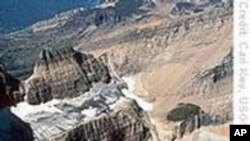<!-- IMAGE -->
Glaciers cover 15 million square kilometers of the earth's surface, or a little less than the total area of the South American continent. Most of the world's glacial ice is in Antarctica and Greenland, but glaciers are found on nearly every continent, even Africa.
The National Snow and Ice Data Center finds most of the world's glaciers are thinning, as more snow melts in the summer than accumulates in the winter. That's as true in the Himalayas as it is in the mountains of the American West.
<!-- IMAGE -->Andrew Fountain, a professor at Portland State University, notes that, "Glaciers in Montana have receded about 56 percent. So they've lost over half their area since the turn of the last century. Those in California, like in the Sierra, they're close to that with 52 percent area loss."
Fountain assembled an inventory of Western glaciers for the National Science Foundation. He found that the vast majority of those masses of ice and snow are shrinking. But Fountain counts about eight exceptions among the several hundred glaciers he's tracking in the American West.
Shadows help Crater Glacier grow
<!-- IMAGE -->Crater Glacier on Mount St. Helens, in southwest Washington State, is one of those. Hydrologist Joe Walder, a researcher with the U.S. Geological Survey, has been studying the glacier. The crater is a windy and often dangerous place to work, due to avalanches and falling rocks. "Snow avalanches off the crater walls constantly during the winter," he says, so some of his work is done from a volcano observatory about eight kilometers away.
Walder says Mount St. Helens' massive 1980 eruption created the perfect setting to form a new glacier. The north-facing crater has steep walls that shade the bowl nearly year round. It acts like a baseball catcher's glove reaching for the jet stream.
<!-- IMAGE -->The ice field got pushed around by the volcano's most recent lava extrusion. But the mass survived. Now, Walder notes, the glacier has grown so fast, it has overrun instruments placed to track it. "It is advancing something like a hundred meters – 300 feet – in a year, roughly speaking," he says.
But that should not create any doubt about global warming, Walder insists. He classifies Crater Glacier as the exception. "It doesn't bear on the general phenomenon of glacier retreat throughout western North America," he says.
Warmer oceans help some mountaintops keep their glaciers
At the southern end of the Cascade Range rises a different snow-capped puzzle. It's Mount Shasta. Measurements of Shasta's glaciers show fifty years of nearly continuous expansion. Professor Fountain the leading theory is that increased amounts of snow caused the growth. "That area has been subject to enhanced precipitation. When you're above the freezing level, that precipitation is snow and those glaciers have responded."
The increased moisture comes thanks to a warming ocean. Fountain says the same mechanism is helping some glaciers on the Pacific Northwest's tallest peaks, such as Mount Rainier and Mount Baker, to hold their own.
Scientists say this glacier growth is temporary
<!-- IMAGE -->But Fountain figures these glaciers can't resist the global trend much longer. "We do expect it to be a temporary phenomenon. The modeling done down on Mount Shasta expects the glaciers to retreat within the next decade or so, if they're not already. And we fully expect the glaciers to begin to retreat more rapidly on these volcanoes in Washington and Oregon," Fountain says.
He adds that climate models call for the snow line to rise. If that happens, less glacier surface will be nourished by snow and more will be eroded by rain, and the growing glaciers will start to shrink.








